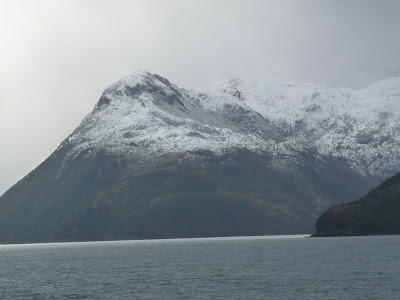After we leave Punta Arenas, we head into the Strait, and the same day also Cockburn and Beagle Channel. We arrive at Ushuaia, Argentina on the 21st.
Length 330 miles
Satellite View


The straits of Magellan lies a little to the north of Cape Horn, approx. 200 miles
We are in the Tierra Del Fuego (Land of fire is a moniker because of the cold!) Split down the middle between Chile and Argentina. The Argentina side boasts Ushuaia and the impressive Darwin Range.
Sources of the name, Land of Fire, come from either the crimson and orange beech forests or when the indigenous people kept many small fires to keep warm.
An interesting little story!Canadian Invasion! Forget guns, germs and steel, Canadian beavers are using back teeth and broad tails to colonize Tierra del Fuego. It all goes back to the 1940's when Argentina's hapless military government imported 25 pairs of beavers from Canada, hoping they would multiply and in turn, generate a lucrative fur industry in this largely underdeveloped area. Well, with no natural predator they did multiply, but beaver hats became as fashionable as whalebone corsets and the beaver industry floundered. These days, there are estimated to be some 250,000 beavers on Tierra del Fuego and surrounding islands. The chunky rodents chip down all the best trees, dam up rivers and make their own pond. each beaver pond contains hundreds of dead tree trunks. Beavers are now considered a plaque, loggers are in competition with the beavers for the best wood and are in fear of losing their livelihoods. The dams also create flooding, destroy roads and poo in the lakes which gets into their water supplies and work its black magic on human intestines!
Past government programs to reduce the animal numbers (paying US $1.50 per dead beaver). Rights activists has turned government officials against one another. Some are trying to make beaver spotting a popular side excursion but are also worried about devastation to the picturesque countryside. On a positive note, beavers need to live in water, so they can only spread so far cross the land and they don't reproduce at the insane rate of rabbits or some other rodents. Maybe the government should import a few thousand of the beaver's predators from Canada, like bears, wolves or coyotes- or maybe not! some are concerned that the beavers could accidentally make their way across the Strait of Magellan and the South American continent. Next stop...the Amazon!

I know we are in the Cockburn and Beagle Channels. More glaciers


VERY BEAUTIFUL!!!!



A melting glacier, with a river of fresh water, running to the sea. This was once ALL ice!!

Something I forgot to mention about Punta Arenas is we are right under a huge gaping atmospheric ozone hole, which hovers over this area and Antarctica. Ozone plays a important role in the absorption of solar rays and in turn regulates temperatures and wind patterns. We..around the world have contributed to this with gases used in aerosols, refrigeration, air -conditioning, industrial solvents and other chemicals. It has impacted this area more than any other inhabited area on earth. It is particularly bad during the Spring and allows daily danger levels of strong UV rays to jackhammer down on both humans and animals. Posters display the daily danger levels all around Punta Arenas. Everyone wears wide sun hats and sun glasses Even when the sun doesn't feel strong, you can feel a slight stinging sensation as the sun dries your skin.
Tom continues to not feel well, with the pain in his groin, but just won't go see the doctor on board. Hopefully tomorrow he will feel better.
Tomorrow Ushuaia, Argentina


No comments:
Post a Comment
I'd love to hear from you readers. Please leave at least 'hello" to let me know someone is reading this! Thanks and a hug in return!